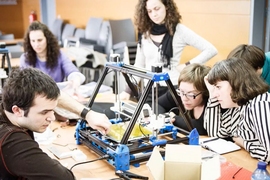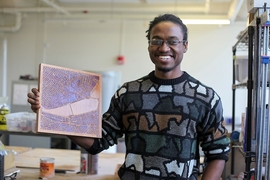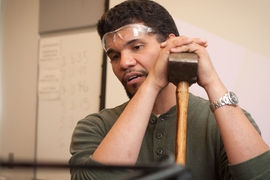The maker movement is on the rise.
From electronics to robotics, metalworking to woodworking, jewelry making to composting, popular fascination with the maker culture is quickly spreading and inspiring a new crop of do-it-yourselfers.
As a home of making, MIT is no stranger to this movement. With over 40 spaces dedicated for the MIT community to build, design, and tinker, the Institute is even more committed to maximizing the impact of making upon academic and extracurricular life.
To advance this mission, two new programs will debut to get students making faster and earlier. Starting in fall 2016, every MIT freshman will be invited to the MakerLodge to learn about 3-D printers, laser cutters, soldering, CNC milling machines, and all the other tools spread across MIT’s 130,000 square feet of makerspaces.
Once students prove they can operate the equipment safely and competently, they’ll gain access to 10 makerspaces and receive MakerBucks, a debit account of $100 to purchase materials and time on the machines of their choosing around campus. They’ll also be matched with communities of other students who have shared interests, such as in robots, glasswork, or woodworking.
"These programs are designed to welcome and empower the next generation of inventors and innovators," says Martin Culpepper, professor of mechanical engineering and MIT’s "Maker Czar." "We know from past surveys that our students typically spend $50 to $150 of their own money to engage in making," he adds. "And they have also told us that campus resources are difficult for them to access."
Along with Mobius, a recently launched mobile app that helps students navigate the maze of campus maker facilities, future MIT makers will be greeted with a complete maker package.
“All MIT students will have increased access to training, facilities, funding, and community,” said Ian A. Waitz, dean of the MIT School of Engineering, who has long sought to shore up more resources for student makers. “Similar to other new education programs for seeding innovation like MIT Sandbox, StartMIT, and the Entrepreneurship and Innovation minor, we are determined to lower barriers and open access to all that MIT has to offer. Once we say ‘yes’ to a prospective freshman, we never want to be in a position to have to say ‘no.’”
MakerLodge and MakerBucks is made possible through the generosity of alumni Lynn and John Helferich ’79, SM ’10, PhD ’17 and Meghan and Peter Quigley ’85.
The programs will be run and administered by Project Manus — MIT’s effort to upgrade makerspaces and foster maker communities on campus — with the support of the MIT Innovation Initiative.
“Making is no longer just an MIT thing. This is an important step for MIT,” adds Culpepper, who is also director of Project Manus. “We need to recognize that the culture is shifting and we need to engage with our students on a deeper level to cultivate their passion for building and designing. It’s the balance of ‘thinking’ and ‘making’ that yields the best learning. And who knows what world-changing technology will come out of MIT next as a result.”











